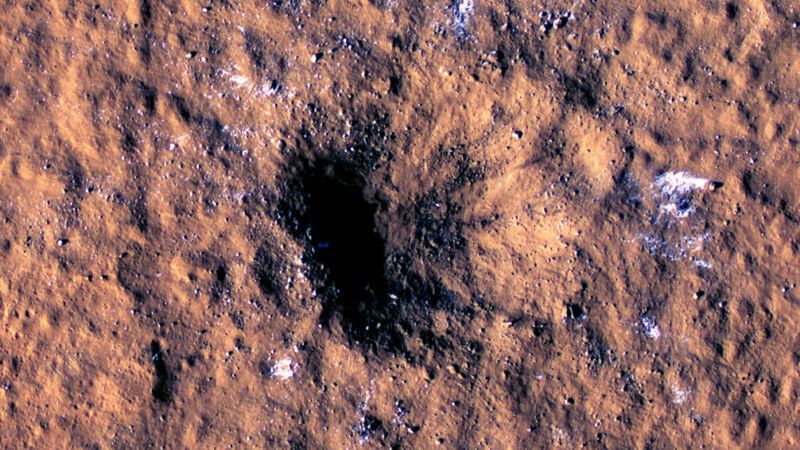What Caused the Most Intense Marsquake Ever?

InSight captured seismic waves released when an impact formed this crater in 2021. But a similar event can’t be tied to any craters.
Earth experiences earthquakes, but Mars experiences marsquakes. The main difference is that marsquakes are often caused by meteoroid crashes since Mars lacks the tectonic plates found on Earth. However, an incredibly intense marsquake occurred without any evidence of a collision. What could have caused it?
The 4.7 magnitude tremors sent vibrations through the Martian crust for at least six hours and were detected by NASA’s InSight lander in May 2022. Named S1222a, this marsquake was initially believed to have been triggered by a meteoroid impact. An international team of researchers, led by planetary geophysicist Benjamin Fernando, started searching for a fresh crater. However, they couldn’t find one. This led them to consider the possibility of an underground process at work.
“We thoroughly investigated the area where the marsquake occurred,” Fernando and his team explained in a recently published study in Geophysical Research Letters. “We didn’t find any new craters, suggesting that the marsquake was likely caused by geological processes.”
An Unexpected Culprit
If a crater had been formed by S1222a, it would have been impossible to miss. Based on estimates, the crater would have had to be at least 300 meters (about 1,000 feet) in diameter.
Previously, InSight had recorded eight marsquakes caused by impacts, with the largest two being 150 meters (500 feet) in diameter each. There were similarities between those events and S1222a. These were the only three cases where seismic waves were observed on the surface, and the waves lasted for extended periods, reaching 10.5 hours for S1222a. Furthermore, all three events had a broader range of frequencies compared to other marsquakes. These similarities initially suggested another impact quake, but there were noticeable differences.
Despite the similarities, the magnitude of S1222a far exceeded the other two similar marsquakes, and it produced a wider variety of seismic waves. Despite this, Fernando and his team decided to search for an impact crater. The craters from the previous two events had darker blast zones, visible even in low-resolution images from the Mars Reconnaissance Orbiter’s MARCI instrument. Therefore, S1222a would have had an even larger blast zone. However, no crater or blast zone was found.
If S1222a had been caused by an impact and a crater had formed, the scientists concluded that one of two things must be true. Either the crater was too small or its blast zone couldn’t be detected by current instruments. Alternatively, it may have formed on a peculiar part of the surface with little dust, making it difficult to see. However, this hypothesis was ruled out as S1222a was localized to an area covered with reddish dust. Even images from various spacecraft with medium and high-resolution showed no craters or blast zones matching those created by S1222a.
A Mystery Beneath the Surface
If it wasn’t a meteorite impact, what caused the largest marsquake ever recorded? Since there was no massive crater, blast zone, or dust clouds matching the magnitude of S1222a, the team concluded that subsurface forces must have been responsible.
“The only explanation consistent with current observations is a subsurface tectonic source,” the researchers stated in the same study.
But how can there be subsurface tectonic forces on Mars without tectonic plates? Tectonic forces can be generated by any significant effect on a planet’s crust, not just by the movement of plates. Fernando suggests that S1222a may be the result of immense stress on Mars’ crust caused by cooling and shrinking over billions of years.
These processes don’t occur uniformly across the entire planet. Different regions experience changes at different times, and why some areas of Mars are more stressed than others remains a mystery that scientists are actively investigating.
Tectonic forces on an alien planet may differ greatly from those on Earth, but at least the main suspect responsible for S1222a has been ruled out. Future spacecraft equipped with even more powerful seismic wave detection capabilities than InSight may gradually unveil the secrets of the Martian subsurface.
Geophysical Research Letters, 2023. DOI: 10.1029/2023GL103619.

